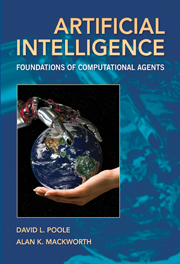Book contents
15 - Retrospect and Prospect
from V - The Big Picture
Summary
Computation is the fire in our modern-day caves. By 2056, the computational revolution will be recognised as a transformation as significant as the industrial revolution. The evolution and widespread diffusion of computation and its analytical fruits will have major impacts on socioeconomics, science and culture.
–Eric Horvitz [2006]In this chapter, we stand back and give a big-picture view of what we have covered. By placing many of the representation schemes in the design space we introduced earlier, the relationships among the representations become more apparent. This allows us to see where the frontier of AI research now lies and to get a sense of the evolution of the field. We also consider some of the many social and ethical consequences that have arisen from the development and application of intelligent computational agents. As Horvitz points out in the quote above, computation is changing the world; we must be aware of its positive and negative impacts.
Dimensions of Complexity Revisited
What has AI research achieved? Where do the current frontier issues lie? To get a systematic sense of the big picture, we use the design space for AI systems presented in Section 1.5 (page 19). There, we described nine dimensions that span part of that design space. In this section, we show how some of the representations presented in the book can be positioned in that space.
Information
- Type
- Chapter
- Information
- Artificial IntelligenceFoundations of Computational Agents, pp. 625 - 632Publisher: Cambridge University PressPrint publication year: 2010
